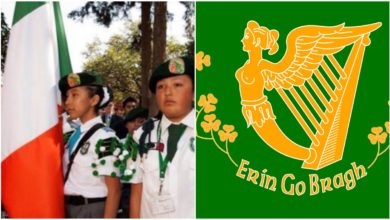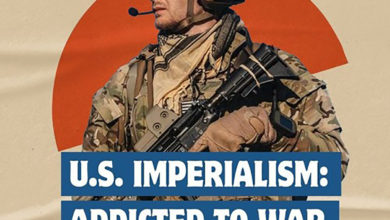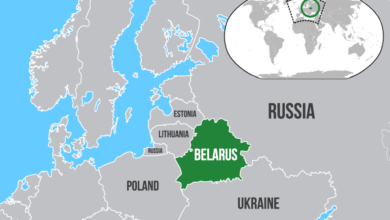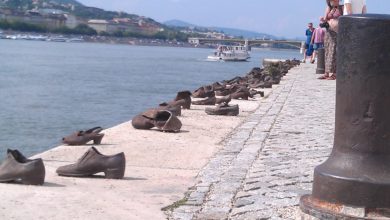A number of events took place in May in Ireland that will radically change the centuries-long struggle for Irish national liberation against British imperialism. Most notably, on May 8, Sinn Fein, the most prominent party advocating an end to British rule in Ireland, joined a home-rule government in the Six Counties of British-occupied northern Ireland with the pro-British Democratic Unionist Party.
Sinn Fein also is expected to continue its growing electoral successes in the 26 southern counties of the Republic of Ireland in the May 24 general elections. In the weeks leading up to the elections, Sinn Fein was polling close to 10 percent of the vote in the multi-party elections—up from 6.5 percent in 2002 and 2.6 percent in 1997.
Sinn Fein is therefore aiming at becoming a major factor in the governments in both North and South. As the only party that actively promotes a united Ireland that is in such a position, it is seeking a position of greater leverage to unify the country—or so at least is the plan.
Reviewing the centuries-old struggle for Irish independence is helpful in understanding these inter-related events and anniversaries.
Ireland is an island to the west of Britain. It was first invaded by King Henry II of England in 1171. British rule was gradually extended to the whole island by 1603, although rebellions and uprisings continued.
Six counties in northern Ireland were given to Scot Presbyterian landowners, who were Protestants. This meant that land was in the hands of Protestants in the north, whereas land in the rest of Ireland was given to landowners of various backgrounds. Local Irish landowners were predominantly Catholic. For this reason, land disputes between big landowners—the ruling class of the day—inevitably took on religious overtones.
The British consolidated power by employing strict repressive measures against the Irish. For example, Irish with property were not allowed to vote in local parliamentary elections until 1788 or sit in parliament until 1829.
Following an uprising against British rule led by Protestant Theobald Wolfetone in 1798, the British set up sectarian militias to harass and terrorize Catholic neighborhoods where nationalist sentiment ran high. They also sought to shape the struggle as one between Catholics and Protestants as opposed to Irish against British colonialism.
Parliament or armed struggle?
By the beginning of the 20th century, the struggle for Irish independence had two main axes. On the one hand, liberal parliamentarians sought to make a case for “home rule”—a kind of self-governance within the confines of British colonial rule—within the British Parliament.
These efforts gradually lost the confidence of the broad Irish masses for two reasons. In 1912, the British funded the creation of a paramilitary terrorist group, the Ulster Volunteer Force, to widen the terror against anyone advocating an independent Irish republic of any kind—even moderate “home rule.”
At the same time, as World War I approached, any hopes for home rule were dashed against the needs of British imperialism to strengthen its hold on its colonies.
The second form that grew up in this period was the resurgence of the armed Irish liberation struggle. Beginning in about 1910, Thomas Clarke, Sean MacDermott, Patrick Pearse and others revived the Irish Republican Brotherhood, an armed liberation group that had been formed decades earlier. The IRB modeled themselves after the French Jacobins and considered themselves socialists. “Republicans” became the accepted term for those advocating an independent Irish republic.
Another group, the Citizens Army, based itself in the urban working class. It had close ties to the Irish Transport and General Workers Union, led by socialist James Connolly.
The Easter Rising
In 1916, on Easter Monday, 1,200 rebels from the IRB and the Citizens Army attempted to take strategic locations in Dublin, hoping to spark a national uprising. Coordinated uprisings that had been planned around the country did not materialize, however.
Ultimately, they succumbed to the British forces. Thousands of republican combatants, sympathizers and suspected sympathizers were rounded up and arrested. Sixteen of the leaders of the rebellion, including Connolly, Pearse, MacDermott and Clarke, were executed.
In the wake of the Easter Rising, Republican forces attempted to regroup. The last rebel commander to surrender in the Easter Rising was Eamonn de Valera, leader of the Sinn Fein (“We Ourselves”) party. Sinn Fein had been formed in 1905 to create an Irish parliament. After the Rising of 1916, it became the political wing of the revolutionaries.
DeValera was elected president of Sinn Fein in 1917 at the Sinn Fein Ard Fheis (convention). Sinn Fein won a majority of Ireland’s parliamentary seats in the subsequent elections of 1919, even though 36 out of the 73 Sinn Fein elected officials were in prison. Instead of taking their seats in the British Parliament, they created an Irish parliament or Dail. The only country to recognize the parliament was the recently formed Union of Soviet Socialist Republics.
The birth of the IRA
Meanwhile, Michael Collins and other leaders attempted to rebuild the IRB. At the first Sinn Fein Dail, the body announced the formation of the Irish Republican Army.
The IRA waged a guerrilla war against British rule beginning in 1919. The British authorities tried to wage a counterinsurgency campaign based on infiltrators and spies. But Collins, a master of political-military organization, built a network of volunteers who spied on the spies. The IRA created a group called the “Twelve Apostles” who assassinated British agents one by one, causing sheer panic among the British police forces.
Sinn Fein continued to win elections for councils and government offices. The IRA military campaign left 600 British police and functionaries killed and 1,200 wounded between 1919 and 1921.
The war forced the British to the negotiating table—but not before British King George V imposed the 1920 Government of Ireland Act, which in effect partitioned Ireland into the six counties of the north and the 26 counties of the south.
DeValera sent IRA leader Michael Collins to the negotiations. The agreement that emerged in 1921 allowed for an Irish Free State—a self-governing entity within the British empire, similar to Canada or Australia. The Free State required that public officials take an oath of allegiance to the crown and allow Britain use of its military facilities and other benefits in time of war.
It also allowed northern Ireland—by then, the most industrialized part of Ireland—to withdraw from the new government and remain allied to Britain.
‘Free State’ and civil war
The Irish Free State was formed in 1922. Collins helped organize a provisional government and a national army.

In the aftermath of the 1916 Easter Rising, British troops inspect the ruins of the General Post Office.
|
But the treaty—especially the continued status of Ireland as a territory within the British empire—proved to be controversial within the Irish liberation movement that had just fought and shed blood for complete independence.
In arguing for the treaty, Collins characterized it as a stepping-stone to actual independence. The struggle to free the north would continue, he argued, after the new Irish nation could steady itself.
DeValera led the anti-treaty faction. The British fueled the division in hopes that both sides would attack each other. In fact, a civil war broke out between the two factions. The year-long war was brutal, particularly because once-comrades were now killing each other. Collins himself was assassinated in August 1922 at the age of 31.
The anti-treaty forces ultimately lost the war. But in 1949, in the wave of anti-colonial ferment after World War II, Ireland declared itself a republic.
The struggle in the north, however, continued. Catholics were still denied jobs and housing. Right-wing loyalist paramilitary groups continued their bloody attacks.
A new civil rights movement

Over 100,000 attended the funeral of hunger striker and political prisoner Bobby Sands in 1981. Sands’ hunger strike became a focal point of struggle.
Photo: Morvan/SIPA
|
This open discrimination against Catholics led to rebellions in many communities. In 1969, youth staged a two-day uprising in the Catholic neighborhood of Bogside, near Derry, emboldening the nationalist communities. It also provoked a wave of repression from the British occupiers, who set curfews in nationalist areas only, jailed nationalists without trial and tortured them.
Events like the Battle of Bogside gave rise to a new civil rights movement, which took inspiration from the U.S. civil rights movement. Thousands of Catholics and nationalists took to the streets.
In 1972, British soldiers fired on a civil rights march in Derry, killing 13 protesters including six children. That event—now known as Bloody Sunday—along with the rising civil rights movement, led to the rapid growth of the Provisional IRA, which traced its roots to the original IRA. The Provisional IRA’s initial goal was to bring about a united, free and socialist Ireland.
The battles that ensued from the late 1960s to 1998 were euphemistically known as “the Troubles.”
Battles raged between the Provisional IRA and other nationalist forces on one side, and the British Army, the Royal Ulster Constabulary police, as well as right-wing paramilitary groups like the Ulster Volunteer Force and the Ulster Defense Association, on the other. The paramilitary forces functioned like a secret police and fascist force with the support, intelligence and aid of the British.
These civil rights protests led to the prison protests beginning in 1976. These protests by nationalist prisoners demanded recognition as political prisoners and captured the world’s attention. Most notable of these was the hunger strike led by Provisional IRA commander and prisoner Bobby Sands beginning on March 1, 1981.
Sands died 66 days later, on May 5, 1981. Nine other prisoners also died before the hunger strike was called off in October 1981. But out of the world outcry against the British treatment of the prisoners, Sinn Fein emerged as a greatly strengthened national force.
Gerry Adams and the political struggle
Two years later, in 1983, Gerry Adams became president of Sinn Fein. The same year, Adams—who had risen through the ranks of the Provisional IRA and Sinn Fein—was elected the first Sinn Fein representative to the British House of Commons since 1955.

Sinn Fein leaders Gerry Adams, left, and Martin McGuiness have won a “seat at the table” in the northern Ireland local government.
Photo: Adrian Dennis/AFP/Getty Images
|
Sinn Fein’s strategy since Adams became president has been to emphasize the electoral and political arena of nationalist work over the military campaign. The latest power-sharing agreement is the fruit of that strategy.
Sinn Fein has been aiming toward a government that would govern both Catholic and Protestant Irish. However, this government is still a local government under the control of the British. British imperialism retains the upper hand.
What is different about the political landscape today is Sinn Fein’s approach toward a coordinated two-pronged strategy: entering the government in the North as a partner with Protestant loyalists while strengthening their political and electoral campaign in the South.
For years, Sinn Fein was a small party, mostly associated with northern politics and considered the political wing of the IRA’s armed struggle in northern Ireland. In the South, it lagged far behind the two main parties, Fianna Fail and Fine Gael. However, Sinn Fein is putting great effort this year toward the May 24 elections where they expect to greatly increase their vote. Ultimately, it aims to be in the government of both North and South. As the only nationalist party with significant support in the North and South, it hopes to challenge British rule from a dual position of power.
Opposition to joint rule
There is also opposition to the Sinn Fein strategy from within the republican movement. As early as January 1998, Bernadette Sands-McKevitt, Bobby Sands’s sister, told Magill magazine that “Bobby did not die for cross-border bodies with executive powers. He did not die for nationalists to be equal British citizens within the Northern Ireland State.”
Sands-McKevitt is among the most prominent spokespeople for the 32 County Sovereignty Movement. That committee is closely connected to the Real IRA, which broke with the Provisional IRA in 1997 over disagreements over an end to the armed struggle.
The 32 County Sovereignty Movement has also pointed out a key issue for any local government in which Sinn Fein participates: the role of the police.
During the March 2007 elections, the 32CSM issued a Feb. 22 call for “a unifying call for the republican and nationalist community to exercise their right to register their misgivings and opposition to the acceptance of the PSNI/RUC [British police], MI5 [British secret police] and the whole British intelligence services operating illegally in Ireland.”
“Policing is both the visual spectacle of the British Government’s illegal sovereign claim to the six occupied counties and also remains their bulwark against Irish unification,” the 32CSM statement continued. “This has never been acceptable in the past and is not acceptable now despite statements from pro-establishment parties that it is a work in progress.”
On May 8, Sinn Fein’s second most prominent leader and former Provisional IRA Army Council member Martin McGuinness became the deputy first minister in the northern Ireland power-sharing arrangement. Two days earlier, on May 6, McGuinness spoke at a commemoration for the Loughgall Martyrs—eight IRA militia members and a civilian who were ambushed and killed by the British SAS special forces in 1987. “Republicans are now on a political offensive,” he noted. “The challenge for Sinn Fein is to deliver on the undoubted potential which now exists.”
One thing is certain from the long history of Ireland’s national liberation struggle: Until British imperialism is driven from the shores of Ireland, there will be tens of thousands who will defy it.





